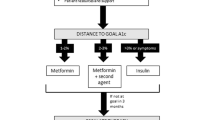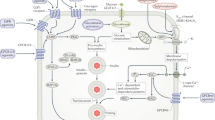Abstract
Uncertainties abound in clinical management of type 2 diabetes. Sources of uncertainty specific to type 2 diabetes originate from the panoply of glycemic (HbA1c) targets, the complexity of drug therapy, the ideal sequence of drugs after metformin failure, the possible harms of anti-hyperglycemic drugs, the outcomes of treatment (surrogate versus clinical) and the hierarchy of risk factors to treat in order to prevent the vascular complications. Ironically, multiple treatment guidelines and algorithms periodically released to improve guidance may generate confusion into clinicians. Moreover, treatment algorithms cannot be truly evidence-based because of a lack of studies comparing all available treatment combination options. Personalized therapy essentially identifies patients who could have major benefits from the therapy as compared with other patients. Personalized medicine for type 2 diabetic has the potential to improve the quality health-care practice of diabetes management, but specific research is needed.
Similar content being viewed by others
References
J. Wennberg, On patient need, equity, supplier-induced demand, and the need to assess the outcome of common medical practice. Med. Care 23, 512–520 (1985)
D. Gianakos, Accepting limits. Arch. Intern. Med. 158, 1059–1061 (1998)
D. Giugliano, K. Esposito, Clinical inertia as a clinical safeguard. JAMA 305, 1591–1592 (2011)
D.R. Whiting, L. Guariguata, C. Weil, J. Shaw, IDF diabetes atlas: global estimates of the prevalence of diabetes for 2011 and 2030. Diabetes Res. Clin. Pract. 94, 311–321 (2011)
W.T. Cefalu, American Diabetes Association-European Association for the study of diabetes position statement: due diligence was conducted. Diabetes Care 35, 1201–1203 (2012)
T.J. Hoerger, J.E. Segel, E.W. Gregg, J.B. Saaddine, Is glycemic control improving in U.S. adults? Diabetes Care 31, 81–86 (2008)
S.E. Inzucchi, R.M. Bergenstal, J.B. Buse, M. Diamant, E. Ferrannini, M. Nauck, A.L. Peters, A. Tsapas, R. Wender, D.R. Matthews, Management of Hyperglycemia in Type 2 Diabetes: a Patient-Centered Approach: position Statement of the American Diabetes Association (ADA) and the European Association for the study of diabetes (EASD). Diabetes Care 35, 1364–1379 (2012)
American Diabetes Association, Standards of medical care in diabetes-2013. Diabetes Care 36(Suppl. 1), S11–S66 (2013)
K. Esposito, G. Bellastella, D. Giugliano, When metformin fails in type 2 diabetes mellitus. Arch. Intern. Med. 171, 365–366 (2011)
D. Giugliano, A. Ceriello, K. Esposito, HbA1c targets for type 2 diabetes: how many, how far! Diabetes Res. Clin. Pract. 96, 414–415 (2012)
S. Colagiuri, Optimal management of type 2 diabetes: the evidence S. Diabetes Obes. Metab. 14(Suppl. 1), 3–8 (2012)
J. Yeaw, J.S. Benner, J.G. Walt, S. Sian, D.B. Smith, Comparing adherence and persistence across 6 chronic medication classes. J Manag Care Pharm 15, 728–740 (2009)
B. Hemmingsen, S.S. Lund, C. Gluud, A. Vaag, T. Almdal, C. Hemmingsen, J. Wetterslev, Intensive glycaemic control for patients with type 2 diabetes: systematic review with meta-analysis and trial sequential analysis of randomised clinical trials. BMJ 343, d6898 (2011)
R. Boussageon, T. Bejan-Angoulvant, M. Saadatian-Elahi, S. Lafont, C. Bergeonneau, B. Kassaï, S. Erpeldinger, J.M. Wright, F. Gueyffier, C. Cornu, Effect of intensive glucose lowering treatment on all-cause mortality, cardiovascular death, and microvascular events in type 2 diabetes: meta-analysis of randomised controlled trials. BMJ 343, d4169 (2011)
D.M. Mann, M. Woodward, F. Ye, M. Krousel-Wood, P. Muntner, Trends in medication use among US adult with diabetes mellitus: glycemic control at the expense of controlling cardiovascular risk factors. Arch. Intern. Med. 169, 1718–1720 (2009)
A. Qaseem, L.L. Humphrey, D.E. Sweet, M. Starkey, P. Shekelle, For the Clinical Guidelines Committee of the American College of Physicians. Oral pharmacologic treatment of type 2 diabetes mellitus: a clinical practice guideline from the American College of Physicians. Ann. Intern. Med. 156, 218–231 (2012)
M.J. Barry, S. Edgman-Levital, Shared decision making—the pinnacle of patient-centered care. N. Engl. J. Med. 366, 780–781 (2012)
M.C. Riddle, D.M. Karl, Individualizing targets and tactics for high-risk patients with type 2 diabetes. Practical lessons from ACCORD and other cardiovascular trials. Diabetes Care 35, 2100–2107 (2012)
O.J. Phung, J.M. Scholle, M. Talwar, G.I. Coleman, Effect of noninsulin antidiabetic drugs added to metformin therapy on glycemic control, weight gain, and hypoglycemia in type 2 diabetes. JAMA 303, 1410–1418 (2010)
J.L. Gros, C.K. Kramer, C.B. Leitão, N. Hawkins, L.V. Viana, B.D. Schaan, L.C. Pinto, T.C. Rodrigues, M.J. Azevedo, For the Diabetes and Endocrinology Meta-analysis Group (DEMA). Effect of antihyperglycemic agents added to metformin and a sulfonylurea on glycemic control and weight gain in type 2 diabetes: a network meta-analysis. Ann. Intern. Med. 154, 672–679 (2011)
K. Esposito, P. Chiodini, G. Bellastella, M.I. Maiorino, D. Giugliano, Proportion of patients at HbA1c target < 7% with eight classes of antidiabetic drugs in type 2 diabetes: systematic review of 218 randomized controlled trials with 78 945 patients. Diabetes Obes. Metab. 14, 228–233 (2012)
C.J. Currie, E.A. Gale, C.D. Poole, Estimation of primary care treatment costs and treatment efficacy for people with Type 1 and Type 2 diabetes in the United Kingdom from 1997 to 2007. Diabet. Med. 27, 938–948 (2010)
Acknowledgments
Nothing to declare.
Author information
Authors and Affiliations
Corresponding author
Rights and permissions
About this article
Cite this article
Esposito, K., Ceriello, A. & Giugliano, D. Does personalized diabetology overcome clinical uncertainty and therapeutic inertia in type 2 diabetes?. Endocrine 44, 343–345 (2013). https://doi.org/10.1007/s12020-013-9918-x
Received:
Accepted:
Published:
Issue Date:
DOI: https://doi.org/10.1007/s12020-013-9918-x




